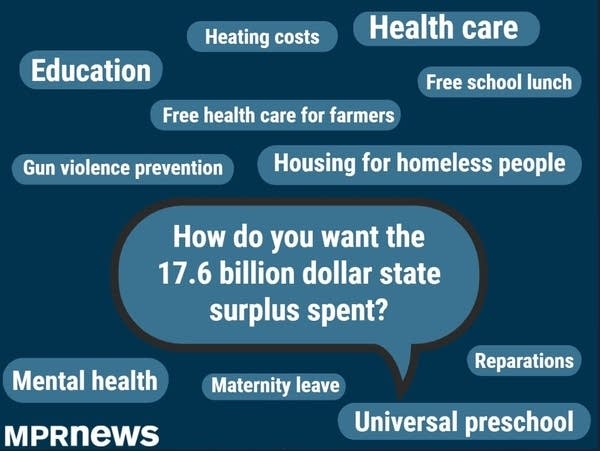How do you think Minnesota should spend its $17.6 billion surplus?

Go Deeper.
Create an account or log in to save stories.
Like this?
Thanks for liking this story! We have added it to a list of your favorite stories.
From creating affordable housing and cutting taxes to funding education and free lunch for students, Minnesotans have many ideas for what to do with the surplus. But how do you actually impact what happens? Here’s how you can make your voice known.
Why does the government have so much money?
In the 2022 legislative session, lawmakers also were working with a large surplus but could not agree on how to spend it, so they left billions of dollars on the table. That surplus is projected to grow through 2025, adding billions more.
“Our income taxes rise very rapidly, our corporate taxes rise very rapidly, our sales taxes rise very rapidly and all of these things have led to more revenue than what was anticipated,” said Jay Kiedrowski, a former Minnesota Finance Commissioner who is now a senior fellow at the University of Minnesota Humphrey School of Public Affairs’ Public and Nonprofit Leadership Center.
Minnesota’s tax collections have been coming in higher than expected and that has helped amass the huge budget surplus.
Turn Up Your Support
MPR News helps you turn down the noise and build shared understanding. Turn up your support for this public resource and keep trusted journalism accessible to all.
“Never before in the history of the state of Minnesota have we had a surplus this large, and even when you look at proportionate to the budget, it is still the largest we have ever had, so that is great news for Minnesota,” Kiedrowski said.
In addition to revenue from taxes, the surplus also grew thanks to “lower-than-projected spending,” according to Minnesota Management and Budget
The Star Tribune reported, “On the spending side, costs for expensive state programs such as health care and education decreased because of an influx of federal COVID-19 aid and lower-than-anticipated K-12 public school enrollment.”
With the surplus now projected at a whopping $17.6 billion, many Minnesotans have their thoughts on how the money should be spent.
What do you think the money should be spent on?
At MPR News, we asked this question on Twitter, Instagram and in forms on our webpage which led to many different answers. The most popular responses were to invest in K-12 education and offer meals for students, to create more affordable housing, and to stop taxing Social Security income.
But people had a whole range of interesting ideas on how to use the budget, including investing in public housing, improving infrastructure, funding childcare centers, creating drug treatment centers and even giving more money to the Minnesota Pollution Control Agency.
On MPR’s Twitter, the comments with the most likes suggested the idea of raising teachers’ salaries.
What do elected officials say they want to spend the money on?
After budget officials announced the surplus, Gov. Tim Walz said, “Now's the time to lower costs for families. Now's the time to reduce and get some money back in their pockets. Now's the time to make sure that those classrooms are funded with the things that they need to do to make our kids the best qualified workforce in the world."
Walz said he wants to give rebate checks to Minnesotans. He told MPR News he supports raising the threshold where state taxes on Social Security income kick in, but not outright abolishing the tax. He also wants to fund a program offering paid family and medical leave.
Republicans want to cut taxes, but Democrats control the House, the Senate and the governor’s office, so Republicans are unlikely to prevail in the debate.
How is a state budget made?
Minnesota Management and Budget notes that the creation of a new budget begins in even-numbered years. The commissioner of Minnesota Management and Budget has the responsibility of sending budget forms and instructions to all state agencies, who must show receipts for the two most recent fiscal years, estimated spending and receipts for current year, and estimates for each tax year of the upcoming biennium.
With the information provided by the state agencies it is used as a guide for the governor to propose a biennial budget. The governor is required to submit a three-part budget to the Minnesota Legislature, which will then make its way through the Legislative process, and once approved and passed it moves back to the governor who has the decision to accept, not accept or change parts of it.
The legislative session begins Jan. 3 and Walz plans to release his budget proposal on Jan. 24.
How can you tell the government how you want them to use the money?
“It starts with calling or writing to the governor's office, who has people to write and summarize information to pass on to the governor. The same would be true with legislative leaders – our residents should write to their representative, their senator. I suggest they also write to the tax committee chairmen sharing their opinion on what should happen for the state of Minnesota,” Kiedrowski said.



